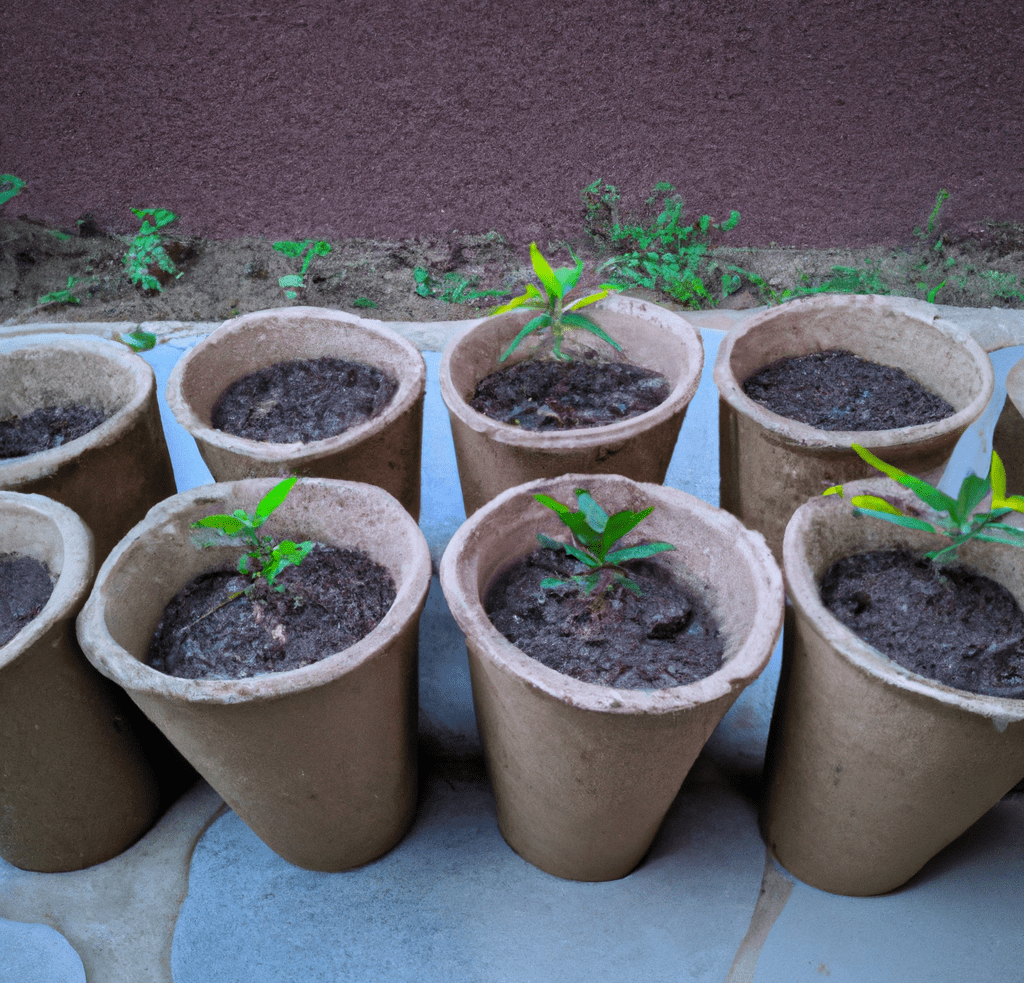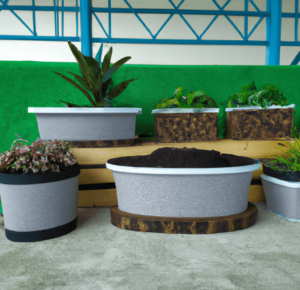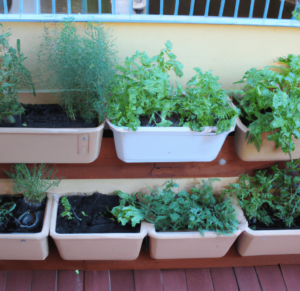Growing your own fresh food and interacting with nature are two wonderful benefits of gardening. Traditional plastic planters, on the other hand, disintegrate slowly and might harm the environment. Fortunately, biodegradable planters are a more environmentally friendly option. These compostable containers have several advantages for your garden because they are composed of natural materials and decompose swiftly in soil. Planters that decompose quickly are often built of materials like bamboo, coconut coir, rice husks, or molded fiber. At the end of the growing season, they may easily be composted or just buried in your garden, unlike plastic planters.
This helps to increase the organic matter in the soil while also reducing waste. Biodegradable planters are advantageous for the plants themselves as well. These containers’ porousness provides for greater air circulation and drainage, which can guard against root rot and other illnesses that are transmitted through the soil. Additionally, they act as insulators for the soil, keeping it warm in the winter and cool in the summer, giving your plants a more stable climate to develop in. Let’s dive into the benefits of using biodegradable planters in your garden!

What Are Biodegradable Planters
Eco-friendly planters that may decompose organically over time without endangering the environment are known as biodegradable planters. They come in a variety of forms, dimensions, and materials, including paper, coconut coir, peat, and compressed manure, and they provide a sustainable gardening option. When it’s time to transplant, biodegradable planters can be buried directly in the ground and offer plants better air circulation, water drainage, and root growth.
Gardeners who wish to lessen their environmental impact might choose to use biodegradable planters because they are practical and economical. The benefits of using biodegradable planters in your garden include that they’re portable, lightweight pots provide a green alternative that is good for the environment and the plants. Biodegradable planters are a great way to support a sustainable and healthy environment in addition to being a useful gardening option.
Define Biodegradable Planters and Explain How They Differ From Traditional Plastic or Clay Planters.
Gardeners that care about the environment are getting more and more interested in biodegradable planters. the benefits of using biodegradable planters in your garden include that they’re constructed of organic materials that can naturally decay without endangering the environment. Traditional plastic or clay planters, on the other hand, are not biodegradable and might take a very long time to decompose.
The fact that biodegradable planters are constructed from substances that may be broken down by soil-based microbes is one of their main advantages. This means that a biodegradable planter can be composted along with the soil and plants when it is no longer required, supplying nutrients for new plant growth.
Traditional plastic or clay planters, on the other hand, must be thrown away and frequently wind up in landfills, where they can take hundreds of years to degrade. The ability to aid with water conservation is another advantage of biodegradable planters. Traditional plastic or clay pots can heat up in the sun, causing the soil’s water to evaporate more quickly. Biodegradable planters, however, are frequently composed of materials that can absorb and hold water, keeping the soil moist for a longer time.
The Materials Used to Make Biodegradable Planters, Such As Peat Moss, Coconut Coir, and Paper Pulp.
Since plastic planters have such a detrimental effect on the environment, biodegradable planters have become more and more popular. Planters that degrade organically without affecting the environment are called biodegradable planters. As you learn about the benefits of using biodegradable planters in your garden, here are the different materials you can choose from:
- Peat Moss: Due to its strong water retention qualities, peat moss is a popular choice for biodegradable planters. It is created from sphagnum moss that has partially decomposed. Peat moss is also portable and effectively insulates plant roots. In many potting mixtures used in horticulture, it is a typical element. Peat moss planters disintegrate gradually, feeding plants with nutrients as they do so.
- Coconut Coir: Another common component for biodegradable planters is coconut coir. The fibers that cover the coconut shell are used to make it. Coconut coir is abundantly available and a renewable resource. As it offers good drainage and aeration, it is a great option for plants. Additionally pH neutral, coconut coir planters do not alter the soil’s pH equilibrium. Planters made of coconut coir break down quickly and add nutrients to the soil.
- Paper Pulp: Paper pulp is a sustainable material that can be used to create biodegradable planters. It is constructed from cardboard and recycled paper. Planters made of paper pulp are portable and effectively retain water. They offer a favorable environment for plant development and make it simple for roots to plow through. Planters made of paper pulp decay quickly, adding organic matter to the soil.
Diving deeper into the benefits of using biodegradable planters in your garden? Get to know these materials and your options.
Advantages of Using Biodegradable Planters
Just like understanding and using different types of potting soil in planters, the benefits of using biodegradable planters in your garden are plenty:
- Environmentally Friendly: Since they don’t add to the buildup of non-biodegradable waste in the environment, biodegradable planters are a sustainable option for gardening. They are built from sustainable materials and are simple to recycle or compost after use.
- Healthy Soil: By promoting drainage, aeration, and water retention, biodegradable planters can increase soil health. These planters enable root penetration through the container walls, lowering the possibility of root-bound plants and promoting soil health.
- Reduced Transplant Shock: Without removing the plant from the container, biodegradable planters can be planted directly into the soil. By doing this, the possibility of transplant shock is removed, which can stress plants and hinder their growth.
- Cost-Effective: Since biodegradable planters do not need to be replaced as frequently as conventional plastic or ceramic planters, they are inexpensive and can result in long-term financial savings.
- Versatile: Because biodegradable planters come in a variety of sizes, shapes, and designs, they may be used for a wide range of gardening tasks, including seed beginning, plant propagation, and container gardening.
These are a few of the benefits of using biodegradable planters in your garden that have gardeners making purchases left and right.
The Benefits of Using Biodegradable Planters in Your Garden, Including Reducing Waste, Promoting Soil Health, and Being Environmentally Friendly.
Gardeners have been using biodegradable planters more and more recently. These planters are constructed with substances that decompose naturally over time, including newspaper, rice husks, and coconut coir. Traditional plastic planters, on the other hand, might take hundreds of years to degrade, having a substantial negative influence on the environment. Some of the other benefits of using biodegradable planters in your garden include:
- Reducing Trash: Reducing waste is one of the main advantages of utilizing biodegradable planters. Plastic planters can occupy a lot of room in landfills and are difficult to disintegrate. Contrarily, biodegradable planters decompose spontaneously, reducing the amount of waste generated.
- Biodegradable planters are excellent for promoting soil health. Plants may benefit from the nutrients that the planters release into the soil as they decompose. The biodegradable material can also aid in enhancing drainage and soil structure, providing a healthy atmosphere for the growth of your plants.
- Being Eco-Friendly: Choosing biodegradable planters is a sustainable course of action. Utilizing planters that decompose naturally will lessen your environmental effect. Knowing that you are not causing extra plastic waste to be produced might also make you feel good.
- Water Conservation: Biodegradable planters are made to enable water to pass through the container, which can help cut down on the quantity of water your plants need. Biodegradable planters let excess water to drain away, reducing waterlogging and root rot, in contrast to plastic planters, which can hold moisture and obstruct adequate drainage.
- Utilizing biodegradable planters reduces the amount of plastic used in food production, hence promoting sustainable agriculture. You may help make agriculture more sustainable by using biodegradable planters.
Overall, the benefits of using biodegradable planters in your garden ensure a more eco-friendly option for gardening.
How to Use Biodegradable Planters
Traditional plastic containers can be replaced with biodegradable planters composed of materials like wood pulp. They’re a great option for people who wish to grow plants in a way that has less of an impact on the environment. Take the type of plant you’re growing and the size of the pot and its plant growth into consideration when you’re choosing a planter because of the benefits of using biodegradable planters in your garden.

How to Grow Plants in Biodegradable Planters and Take Care of Them
Now that you know about the benefits of using biodegradable planters in your garden, here’s how to take care of them:
- Select the Correct Soil: Use superior soil that is appropriate for the particular plants you are cultivating. Make sure the soil you chose can hold moisture because certain biodegradable planters could need more water than plastic pots.
- Regularly Water Your Plants: Since biodegradable planters tend to dry out more quickly than plastic pots do, you might need to do so more frequently. Every day, check the soil to determine if it’s dry and add water as needed.
- Select the Proper Location: Placing your biodegradable planters in a location with the right amount of sunshine for the plants you are cultivating can help them grow.
Keeping Biodegradable Planters Clean
Now that you know about the benefits of using biodegradable planters in your garden, here’s how to maintain them and keep them clean:
- Check for Damage: Because biodegradable planters might be more delicate than plastic pots, it’s important to routinely inspect them for any damage.
- Clean the planters frequently to avoid any accumulation of dirt or grime. To clean them, just combine water and a light detergent.
- Repot as Required: You can repot your plants into a bigger container if they outgrow their biodegradable pots.
How to Properly Dispose of Biodegradable Planters
Given that the benefits of using biodegradable planters in your garden include being compostable, you can dispose of your planters by doing the following:
- Look at the Packaging: Some biodegradable planters have disposal instructions. For instructions, look at the packaging or speak with the manufacturer.
- Compost: You may put most biodegradable planters in your compost bin because they can be composted.
- Landfill: You can dump your biodegradable planters in the landfill if composting is not an option. In contrast to composting, biodegradable planters could take longer to break down in a landfill.
Bottom Line: The Benefits of Using Biodegradable Planters in Your Garden
Fresh vegetables, better mental health, and a connection to nature are just a few advantages of gardening, a lovely activity. However, due to their detrimental effects on the environment, the usage of plastic planters in gardening has been a source of worry. The benefits of using biodegradable planters in your garden are unparalleled. Planters that disintegrate organically in the soil over time include peat moss, rice husks, and other organic materials like coir. As a result, you won’t have to worry about getting rid of them properly or damaging the environment.
In actuality, as these planters decay, nutrients are released into the soil, enhancing its fertility and structure. Biodegradable pots offer a healthier growing environment for plants. Biodegradable planters allow for optimal drainage and air circulation in contrast to plastic, which can retain moisture and serve as a breeding ground for bacteria and mildew. Plants that are stronger, healthier, and less susceptible to disease as a result. The environmental impact of using biodegradable planters is one of their main advantages. When plastic planters degrade, which takes hundreds of years, hazardous chemicals are released into the environment. You may lessen your environmental impact and minimize your carbon footprint by switching to biodegradable planters.
The Benefits of Using Biodegradable Planters in Your Garden FAQs
Biodegradable planters: what are they?
Plants that can naturally disintegrate over time without harming the environment can be grown in biodegradable planters, which are containers that are environmentally benign. They can degrade through the activity of soil-based bacteria because they are made of organic materials, and when they are no longer required, they can be composted with the soil and plants to provide nutrients for the growth of new plants.
What distinguishes biodegradable planters from conventional clay or plastic planters?
Biodegradable planters, on the other hand, are built of materials that can be broken down by soil-based bacteria, giving them a more environmentally friendly alternative to conventional plastic or clay planters that are not biodegradable and can take a very long time to degrade. Traditional clay or plastic planters must be thrown away since they take hundreds of years to decompose in landfills. The soil is kept moist for a longer period of time with biodegradable planters since they are frequently built of materials that can absorb and hold water.
What components go into the creation of biodegradable planters?
Peat moss, coconut coir, and paper pulp are just a few of the materials that can be used to create biodegradable planters. While coconut coir is an excellent option for plants since it gives adequate drainage and aeration and doesn’t change the soil’s pH balance, peat moss is popular because of its potent water retention abilities. Paper pulp, which is made from cardboard and recycled paper, is another sustainable material that can be used to make biodegradable planters.
What benefits can biodegradable planters offer?
The advantages of utilizing biodegradable planters in your yard include the fact that they are sustainable, environmentally beneficial, and simple to recycle or compost. Additionally, they help plants establish stronger roots and provide greater air circulation and water drainage. They also act as insulators for the soil, keeping it warm in the winter and cool in the summer. Additionally, biodegradable planters can assist enhance the organic matter in the soil while decreasing trash because they gradually decay, supplying plants with nutrients as they go.







